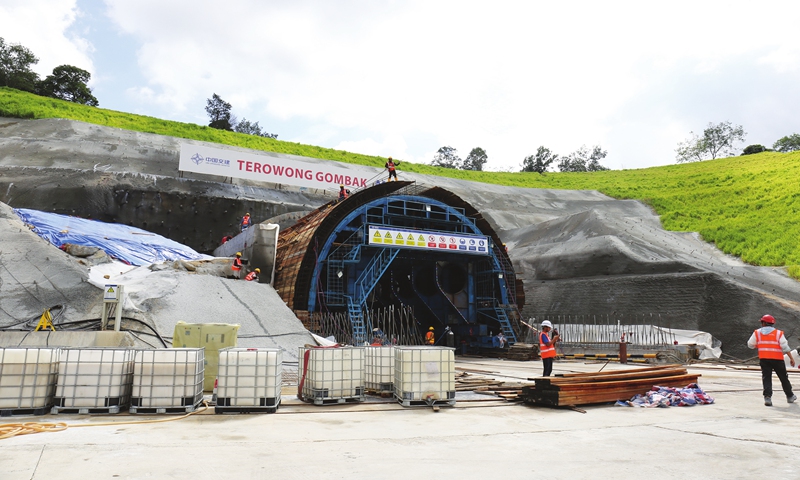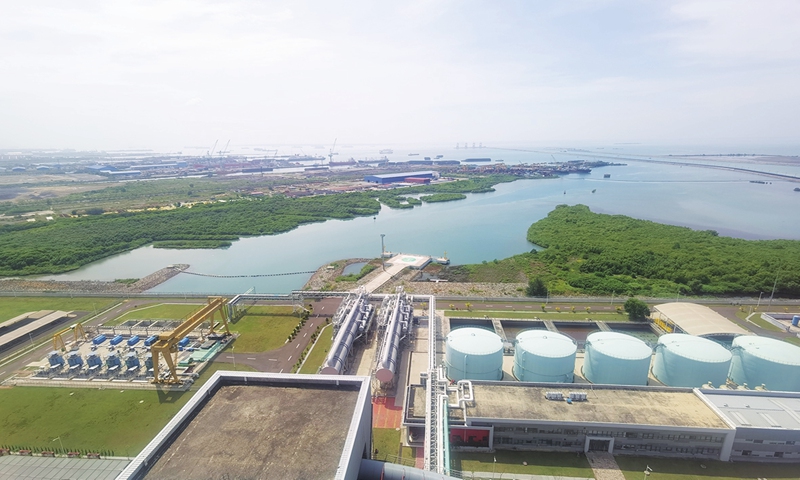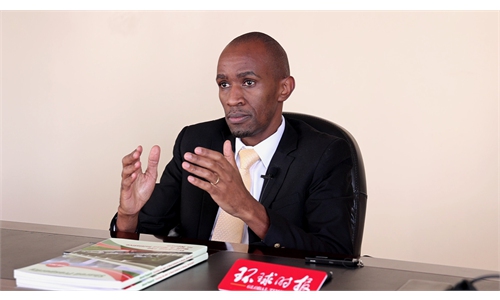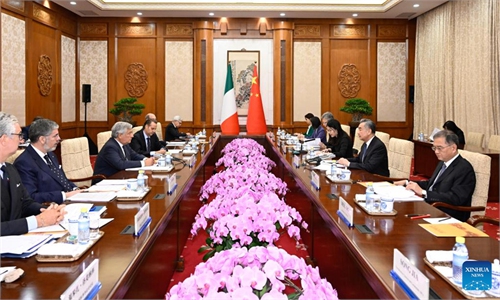
The construction site of BRI flagship project,665-kilometer-long East Coast Rail Link in Malaysia Photo: Zhao Juecheng/GT
Despite constant claims from Western media that the Chinese-proposed Belt and Road Initiative (BRI) is unwelcomed by the people of recipient countries and has caused conflict over environmental and employment issues, a recent fieldtrip by the Global Times to three Southeast Asian countries revealed a very different reality on the ground.
The BRI not only signifies booming investment and employment opportunities, but also highlights a harmony with local communities, from preservation of mangroves, wild elephants, and caring the concerns of local residents. A principle of "extensive consultation, joint contribution and shared benefits" is spreading along the route.
An Indonesia villager named Asip Cenghar, who operates a small shop near the Chinese-built Tegalluar Station, the end point of Jakarta-Bandung High Speed Railway (HSR), has witnessed the development of the rail line from scratch.
Friends for locals
Cenghar told the Global Times that the construction of the Tegalluar Station has boosted his business, and that more nearby vendors have moved in. He noted that some roads in his village have been repaired with the assistance of the Chinese contractor. Cenghar also expressed his appreciation for the sheep that were gifted to him by the Chinese company during Eid al-Adha.
"We are extremely grateful for the high-speed rail project, which has connected our small village to a larger world. It has brought us closer to the capital Jakarta and has demonstrated the efficiency and diverse economic development. Indonesians warmly welcome and eagerly anticipate increased Chinese involvement in infrastructure," Cenghar noted, while refuting groundless claims by Western media that the project has confronted frequent land-related conflict with local communities.
Li Zhenkui, deputy manager of the station project department at China Railway Fourth Bureau Group Corporation, the main contractor for Tegalluar Station, has been regularly visiting nearby villages, streets and neighborhoods since he arrived at Tegalluar construction site in 2019. "I often bring my translator along to visit local residents, to hear their feedback, and did my best to contribute to the local community."
On Li's desk, a stack of photos, letters and invitations from the surrounding community records his interactions with local people. "The neighboring villagers know that Chinese companies are willing to help them, so they write us letters for requests or invitations, from seeking job posts, festival celebration to wedding invitations," said Li.
Li told the Global Times that at its peak, construction of the Tegalluar Station attracted over 4,000 Indonesian workers. The income of these local employees is 30 to 50 percent higher than local average. It is expected that after the railway becomes operational, it will generate thousands of jobs for locals, Li noted. Additionally, the project has benefited local suppliers, leading to increased local spending and lifting economic activity.
Forest well protected
Located in Banten, Indonesia, the Chinese built Java 7 coal-fired power plant is a 2,100MW environmentally friendly power station. It is currently one of the largest and most advanced power plants in Indonesia.
Standing on the observation platform, one can enjoy a panoramic view of the lush and vibrant mangrove forest, where numerous seabirds frolic and mate.
Zhao Zhigang, the general manager of the plant's developer PT Shenhua Guohua Power Jawa Bali told the Global Times that in Southeast Asian countries, local residents attach great importance to environmental protection and consider the natural environment an important foundation for sustainable development. Based on this common recognition, protecting the region's mangrove forest has become a shared responsibility for Chinese and Indonesian operators of the power plant.
Measures such as setting up fences, wire mesh, and mangrove protection signs, as well as designating responsible personnel to oversee mangrove protection in different areas, have been implemented to prevent the rare mangrove forest from being damaged.
Zhao said that during the construction period, any large construction machinery had to detour to avoid the mangrove forest.
When Global Times reporters visited the power plant in July, the area of the mangrove forest had expanded from 9 hectares when construction began to approximately 17 hectares. It has become an ideal home for seabirds, lizards, mongooses and other animals.
The emphasis that Chinese developers place on ecology and wildlife is widely reflected in their meticulous designs and funds which support many BRI projects.
The BRI flagship project 665-kilometer-long East Coast Rail Link (ECRL) also passes through a local forest reserve, which serves as a habitat for wild animals, including Asian elephants, wild boars, black panthers and bears. During the visit, reporters observed numerous culverts of different size that have been designed to accommodate these animals. Some of these culverts are approximately six meters wide and five meters high, allowing adult elephants and other wildlife to pass underneath the railway.
Gao Xiaoyue, the environmental manager for the China Communications Construction Company (CCCC) ECRL Section 6, told the Global Times that CCCC has allocated special funds to monitor the impact on wildlife.
In line with this commitment, the Chinese contractor and the local government signed an agreement on September 30, 2022, to enhance the protection of wildlife along the ECRL. The objective of this agreement is to minimize the environmental impact of the project.
Gao emphasized the significance of protecting wild Asian elephants, which are classified as top-level protected species in Malaysia. She explained that wildlife protection requires meticulous planning and execution.
For instance, in the case of elephant migration, they first track their movement patterns, then dispatch elephant trainers and anesthesia teams, prepare transportation vehicles, disperse the herd, and finally guide the migration. This entire process takes at least two to three years. That's why the Chinese constructor started preparing for animal migration two years prior to the project's commencement by engaging with local departments and assessing their plans.
Gao assured local stakeholders that once the railway is completed, they will restore the land and animal habitats to the best of their ability, in accordance with the requirements of the local authorities.

An aerial view of a massive mangrove growing around the Chinese built Java 7 coal-fired power plant in Indonesia Photo:Hu Yuwei/GT
Talent development
Another reflection of "joint construction and shared benefits" is transferring China's advanced experience and skills in infrastructure construction to host countries, and establishing a talent pool for local development.
The East Coast Rail Link (ECRL), which links the East Coast and the West Coast of Peninsular Malaysia, is the largest transportation facility Chinese companies built abroad. To date, over 20,000 people have been participating in the project, including Chinese, Malaysian and workers from other countries.
An important aspect of the project involves technological transfer. Kong Qi, managing director of China Communications Construction ECRL, told the Global Times that the Chinese company has signed a talent training and cooperation plan with Malaysian authorities. Under the plan, the project will develop 5,000 skilled workers specializing in railway construction and operation.
Muhammad Azril Hakim Bin Usop, a 20-something college graduate who has joined the project for nine months, is currently learning railway skills and expertise from two Chinese "teachers" on site. He told the Global Times that Malaysia is in dire need of more expertise, and hoped that his experience at ECRL will help his country "build more advanced railway facilities."
The 10-day fieldtrip allowed Global Times reporters to appreciate how BRI projects push for high-standard, sustainable and people-centered progress. Behind this effort are the Chinese contractors and the local people who listen to each other, engage with each other, and invest in environmental protection.
The BRI's high-quality development is branching out and delivering results. The projects under the BRI cooperation framework across three Southeast Asia countries have illustrated the economic, social and environmental benefits the BRI can bring to its partners.





